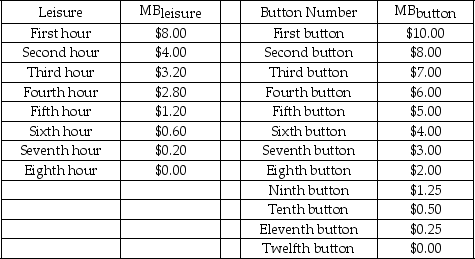Scenario: This problem applies the principle of optimization covered in Chapter 5 to the problem of choosing how many hours to work. Paul has to decide how many hours to work per day. His boss is willing to give Paul whatever hours Paul wants up to 8 hours. All else being equal, he would rather not work, that is, Paul has positive marginal benefit from each hour of leisure. But he is an avid collector of presidential campaign buttons. The more leisure he takes, the fewer buttons he can afford. So Paul faces a trade-off between leisure and buttons. Each button costs $1.00. The table below shows Paul's marginal benefits from leisure (MBlₑᵢsᵤᵣₑ) and buttons (MBbᵤttₒn) .

-Refer to the scenario above.If the hourly wage is $1.00,how many hours would Paul choose to work? How many buttons would he buy?
A) 6 hours; 6 buttons
B) 3 hours; 3 buttons
C) 2 hours; 2 buttons
D) 0 hours; 0 buttons
Correct Answer:
Verified
Q63: The following figure depicts an individual's supply
Q64: If workers are optimizing their total benefit,they
Q65: Non-paying activities in economics are referred to
Q66: Meryl works 10 hours a day in
Q67: Consider a printing press that operates in
Q69: The following figure depicts an individual's supply
Q70: The price of non-work activities is _.
A)
Q71: Meryl works 10 hours a day in
Q72: If leisure is a normal good,how will
Q73: Scenario: This problem applies the principle of
Unlock this Answer For Free Now!
View this answer and more for free by performing one of the following actions

Scan the QR code to install the App and get 2 free unlocks

Unlock quizzes for free by uploading documents